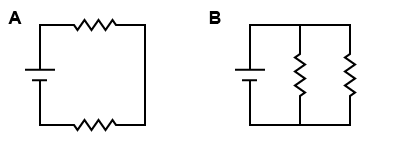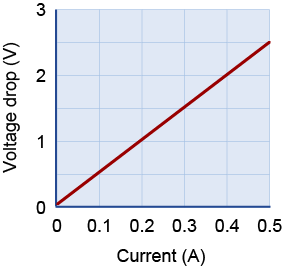
- Consider the two circuit diagrams.
- Which illustration corresponds to a correctly constructed circuit of two resistors connected in series?
- Which illustration corresponds to a correctly constructed circuit of two resistors connected in parallel?
- Why is it a terrible idea to try to connect a mini-lamp bulb to a wall socket?

 Use the parts in the illustration above to draw connections for the following two circuits. Use the parts in the illustration above to draw connections for the following two circuits.
- Connect the two batteries in series with each other. Connect the two resistors in parallel with each other. Connect the two resistors together across the maximum voltage from the batteries.
- Connect the two batteries in parallel with each other. Connect the two resistors in series with each other. Connect the two resistors together across the maximum voltage from the batteries.
- What is the potential difference across each circuit?
- By interpreting the color bands, what is the resistance of each resistor? (Hint: The color bands read brown-black-red-gold.)
- What is the value of the effective resistance for each circuit?
- Three batteries, each having a voltage of 2.0 V, are connected in series. What is the total voltage across them?
 Three batteries, each having a voltage of 2.0 V, are connected in parallel. What is the total voltage across them? Three batteries, each having a voltage of 2.0 V, are connected in parallel. What is the total voltage across them?
| |
 What is the voltage drop across a 50 Ω resistor when a current of 0.1 A flows through it? What is the voltage drop across a 50 Ω resistor when a current of 0.1 A flows through it?
 What is the current through a 10 Ω resistor when a voltage of 5 V is applied across it? What is the current through a 10 Ω resistor when a voltage of 5 V is applied across it?

 A resistor is subject to a variable voltage drop V, and it conducts varying amounts of current I as a result. A student measures these voltages and currents and then graphs the measurements, as shown above. A resistor is subject to a variable voltage drop V, and it conducts varying amounts of current I as a result. A student measures these voltages and currents and then graphs the measurements, as shown above.
- Calculate the slope of the plotted line by using the two endpoints. What is the slope’s numerical value, and what is its unit?
- Does this resistor obey Ohm’s law? Justify your response.
- Which of the quantities in Ohm’s law corresponds to the slope of the plotted line?
 A light bulb produces a light intensity according to the equation where V is the voltage applied to the bulb. A light bulb produces a light intensity according to the equation where V is the voltage applied to the bulb.
The resistance R of the filament in the light bulb is a function of the intensity Int of light and is related to it by the formula If the optimum intensity of the bulb is 12.5 lumens, what are the operating current and voltage?
|

